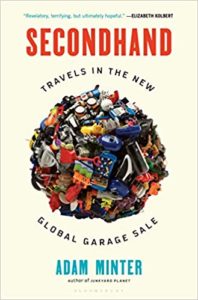
As a knitter, I was fascinated by the discussion of recycled sweaters and recycled yarn in last week’s Econtalk. Russ Roberts and Adam Minter have a brief exchange about how to recycle wool sweaters. Russ posits that, “It’s easy. You just take an end and just start pulling until you get a really long piece of yarn, and you’re done. You get a new piece of yarn. Adam explains that in industrial recycling “What they do is, they take these sweaters and other wool garments, it’s not just sweaters, but wool in general, and it’s essentially chopped up. They have these big machines that rip these garments apart into their individual fibers and then re-roll them into a fabric called ‘shoddy’.”
Crafters do a lot of recycling of yarn, and we do it in ways that replicate both these approaches. Sometimes, we follow Russ’s suggestion and “just take an end and start pulling,” though the full process of raveling a sweater in order to reclaim the yarn is a little more complicated than that. Once we’ve reclaimed the yarn, though, we can knit whatever we like. My friend Vickie Howell is a knitwear designer who used yarn that was reclaimed this way in a design for diaper covers–a very practical use for yarn that’s still functional, if perhaps not at its beautiful best.
If a sweater is so lightweight or so damaged that reclaiming the yarn won’t work, crafters often treat the old sweater as a piece of fabric, cutting and sewing it to produce a new item. When my kids were toddlers I washed several moth eaten wool sweaters in hot water to felt them, put some cute patches over the damaged spots, and turned them into cardigans for the kids. Right now, I’m saving a pile of similarly beat up sweaters to make a blanket.
There is also a growing industry that uses techniques more like the ones Adam describes to make new yarn out of old materials. One of the most popular is yarn made from the recycled silk from saris. But you can find yarn made from recycled blue jeans, old t-shirts, and pretty much any fiber you can imagine. While you can’t buy it yet, crafters are even making yarn from plastic grocery bags to use in a variety of projects where strength and waterproof qualities are important.
The small amount of recycling done by home crafters and small producers of yarn may not make a huge dent in the looming piles of fabric that “your kids don’t want,” but it’s a start. And given that crafters have an ever-increasing demand for yarn and for the pleasure of crafting as a consumption good as well as a household production input, the dent may be larger than we think.


READER COMMENTS
Jon Murphy
Jan 24 2020 at 12:47pm
My mom (who is also a knitter) and I were just talking about precisely this. I never really knew all the ways to recycle and reuse yarn.
Sarah Skwire
Jan 24 2020 at 1:34pm
Jon-
I’m fascinated by the “household economy” approach to recycling–where mom’s old sweater becomes a cardigan for the oldest child, who passes it down to siblings until it’s only fit for a diaper cover, or polishing silver. We don’t teach that to kids any more, and I wish we did.
Comments are closed.